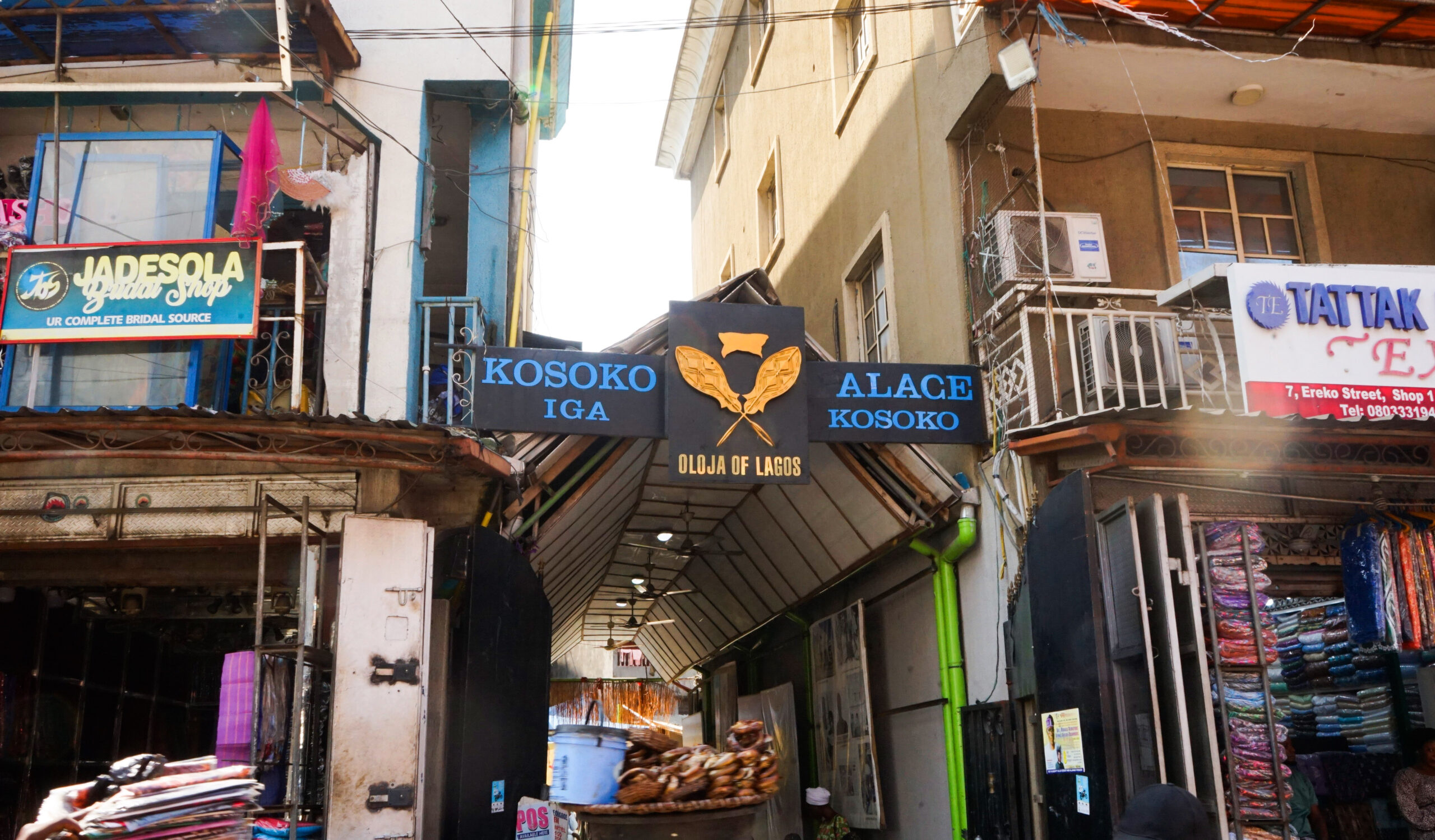News
Oba Kosoko-Oloja And The Socio-Economic History Of Lagos

By Hannah Anthony
Slave business was the business of Iga Iduganran because they had the safest and deepest harbour that every merchant wanted to use as a passage for their goods.

In the late fifteenth century, the Portuguese being the first of the most active European nations to take a notable part in the African slave trade, journeyed down the West African coast to trade for local slaves. While a few African traders, especially the noble class, their households and followers experienced fame, economic benefits and plethora.
Truth to the historical slave trade tale, Prince Abiola Oloja-Kosoko, the Oloja of Lagos Elect, provided exclusive and thought-provoking historical insights about the socio econmic history of Lagos during a visit by the Lagos State Council for Arts and Culture in partnership with the Wiki-Fact Checkers and Wiki-Loves Team to the Oba Kosoko Palace at Ereko Lagos.
“The nickname Kosoko is from the Yoruba phrase, ‘ko si oko ta ma fi gbele’ which was derived from the mysterious circumstances that surrounded his birth but the other part of the name was removed,” he explained.
His great-grandfather was nicknamed ‘Kosoko’ but his real name is Morounfolu Esinlokun.
“Kosoko grew up in the Iga Iduganran palace where his private residence was, the quarters for all princesses and princes of Lagos.”
He revealed that Ologun Kutere, was the Oba of Lagos at the time and his father, Esinlokun, was big in the slave trade business.
“Slave business was the business of Iga Iduganran because they had the safest and deepest harbour that every merchant wanted to use as a passage for their goods.
“That is the Kosoko harbour, now called the Marina. By the beginning of Broad Street to some parts of Isa Williams, it was sand-filled when it was being reclaimed for buildings (1927-1933). The area is also called the Inner Marina.
“The slaves were used for exchange and called bales, a group of twelve slaves equals one bale.
“Esinlokun was away when his father, Ologun Kutere, died. He was busy doing the business of bringing slaves into Langbasa and then to the shoreline where he sold them to the Portuguese.
“He went to Mahin and used the Ilajes and Egun to capture the Ijebu who came to buy fish from them and take them to Ebute Iga, and from there to Langbasa, which is today Esinlokun’s property. There is a Supreme Court judgment that declared that.
“The slave business boomed when Esinlokun became the king, and Kosoko became heir to the throne, being the firstborn male. It was mentioned in his eulogy, ‘Iwo Kosoko Moronfolu, Okun Oye’, meaning the only heir to the throne.
Kosoko also decided to expand his business venture into Ouidah and Dahomey. This led to his property acquisition in Port-Novo and they are still there as we speak. We also have settlements in those communities which makes us citizens of four other countries apart from Nigeria,” he explained.
Being the heir to the throne of his father, Kosoko was entitled to his father’s throne but his business travels and other monarchy system rifts that ravaged the royal family house prevented him until 1845.
King Esinlokun died after spending 25 years on the throne but Kosoko was not in town, they looked for him and couldn’t find him, so after about one year, his younger brother, Idewu, was installed as Oba, the king.
“They still tried to reach him and he was finally found and brought back to Lagos. But there was nothing Kosoko could do since his brother, Idewu, was already on the throne.
Oba Idewu, knowing who Kosoko was, had to ensure Kosoko did not come to meet in the palace. So pronounced him Oloja in 1833. He said to Kosoko, “My elder brother, I can’t allow you to prostrate for me, neither can I take your greeting. Go to Ereko and remain there as Oloja of Ereko”.
At the death of Idewu, they were supposed to call Kosoko but they didn’t. They instead went to Badagry and invited Adele Ajose -kosoko’s uncle- and his wife Tinubu. The night Ajose came into Lagos, Kosoko also came into Lagos. The kingmakers then thought to resolve issues surrounding the two men by consulting them.
OLori Tinubu supported her husband to maintain the throne, with an agreement for Kosoko to take the throne after Adele Ajose. And Kosoko agreed because they already had a relationship.
Kosoko continued as the Oloja and business were booming in the markets. He also appointed ‘Efunroye Tinubu’ as the first Iyaloja of Lagos. Her shop was at the current location of the Central Bank of Nigeria (CBN) building, and the Ereko market spread to where the central mosque stands today.
Photos of Slave chains, ancient artefacts and letters Kosoko used in communicating with the Portuguese.
At the time, there was no name, Lagos. Lagos came into existence in 1852. Kosoko had been communicating with the Portuguese before the English came. His letters were written in Portuguese and before 1851. English became the official language in Lagos on January 4, 1852.
Dada Anthonie and Tapa Oshodi were amongst Kosoko’s inherited slaves. Ajayi Crowther came in at the time the slave business continued slowly in Lagos, he was given to Kosoko instead of the usual levy.
During King Akintoye’s reign, Kosoko joined the palm oil trade when the slave trade business was coming to a halt. He started the commodities market by bringing in Ijebu women to trade in the hinterland, disbanded all the markets on the Lagos shore and focused solely on the port of Palmer.
His men will close down a market, get the leader and goods to Port Palmer and give the goods to the Ijebu women to sell. The market leader will be given money after this.
The Oloja Title
“Only a Kosoko can become the Oloja because it is an office specially created for their father, Morounfolu Esinlokun (kosoko).
“A kosoko will also need to go through the larger Esinlokun Royal House which has 16 other branches, to vie for the Oba of Lagos seat.
“The Oloja title means the Grand Commander and the man in charge of Markets in Lagos and its environments; there is a document to that effect in 1863.
“Oloja is the driver of the Lagos economy. He appoints the Iyaloja. After ‘Efunroye Tinubu’, there was no Iyaloja for several years until ‘Nimota Pelewura’, Iya Eleja became the Iyaloja.
Before she died, there was a group of market women and men association, three of those groups merged, but after all the crisis, then military governor, Mobolaji Johnson called Aminu Kosoko, the third Oloja, to approve the appointment of Alhaja Mogaji who was Iya Alabo lehin Iga Kosoko. She lived in Oluwole,” he explained
“There is also a supreme court judgment that all market associations are representatives and subjects to the Oloja of Lagos and it was assumed so. The Iyaloja-General will pick Balogun Oja (male) and Iyaloja for other markets. But the Iyaloja-General interfaces with the Oloja-owner of the markets.
“I was elected, nominated and got to the palace on December 1, 2020, but still waiting for all the necessary papers,” he added.
-

 News1 day ago
News1 day agoAmb.Okoro commends Rear Admiral Okeke for squashing bunkering
-

 News2 days ago
News2 days agoPrimate Ayodele’s Prophecy On Chad Presidential Election Comes To Pass
-

 News23 hours ago
News23 hours agoWEMA BANK UNVEILS NEW DIGITAL SOLUTION FOR COOPERATIVE SOCIETIES, COOPHUB
-

 News11 hours ago
News11 hours agoEnemi George’s Misguided Loyalty









